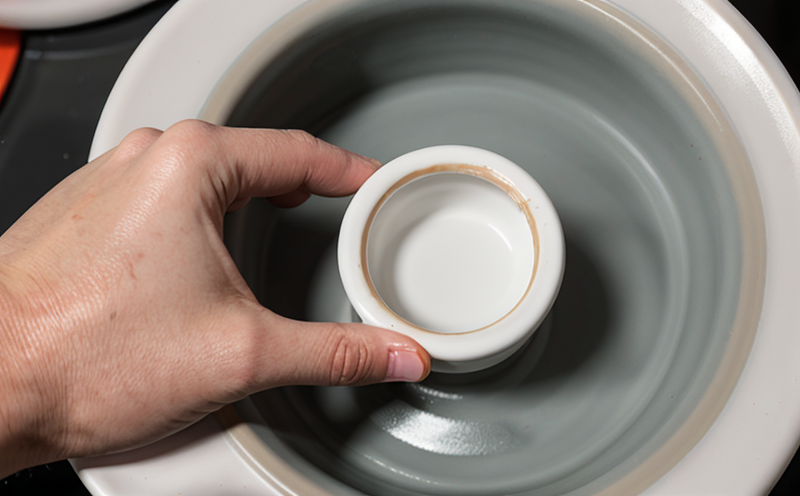ISO 23154 Oxidation Resistance of Nanostructured Ceramic Materials
The ISO 23154 standard provides a robust framework to evaluate the oxidation resistance of nanostructured ceramic materials. This service is critical for ensuring that nanostructured ceramics perform reliably in harsh environments, particularly in sectors such as aerospace, electronics, and medical devices where material degradation due to oxidation can lead to catastrophic failures.
The testing method focuses on measuring the mass change of specimens after being exposed to an oxidizing environment at elevated temperatures. This approach allows for a precise determination of how well the nanostructured ceramic resists oxidation, which is essential for its long-term performance and reliability.
Specimens are typically prepared by sintering or other methods that produce nano-sized particles, resulting in materials with unique properties like high strength-to-weight ratios, excellent thermal stability, and exceptional electrical insulation. These properties make nanostructured ceramics ideal candidates for advanced applications where traditional ceramic materials might not suffice.
The testing process is designed to simulate real-world conditions under which the material will be used. This includes exposing the specimens to controlled atmospheres containing oxygen at elevated temperatures over specified durations. The mass change of the specimen after this exposure period provides a direct measure of its oxidation resistance.
For accurate results, it's crucial to follow ISO 23154 meticulously. This involves precise control of temperature, atmosphere composition, and duration of exposure. The use of advanced analytical techniques such as thermogravimetric analysis (TGA) or mass spectrometry can further refine the assessment by providing additional insights into the nature of the oxidation process.
The reliability of nanostructured ceramics is paramount in industries where failure could have severe consequences. By adhering to ISO 23154, manufacturers ensure their products meet stringent quality standards and are suitable for critical applications. This not only enhances product performance but also builds trust with end-users who rely on the integrity of these materials.
The standard's emphasis on reproducible results makes it invaluable for both research and production environments. It allows different laboratories to achieve consistent outcomes when testing similar materials, thereby facilitating collaboration across industries and geographical boundaries. This interoperability is particularly important given the global nature of modern manufacturing processes.
| Parameter | Description |
|---|---|
| Temperature Range | From room temperature up to 1200°C, depending on material and application. |
| Air Composition | Oxygen content can be varied from 5% to 21%, simulating different environmental conditions. |
| Duration of Exposure | Typically ranges between 1 hour and several days, depending on the specific requirements of the application. |
The ISO 23154 protocol ensures that all these variables are accounted for during testing, leading to more accurate assessments of oxidation resistance. This comprehensive approach helps identify potential weaknesses in nanostructured ceramics early in the development process, allowing manufacturers to make necessary adjustments before scaling up production.
In summary, adhering to ISO 23154 guarantees that nanostructured ceramic materials are thoroughly evaluated for their ability to withstand oxidative environments. This service plays a vital role in ensuring product reliability and safety across various sectors, from cutting-edge aerospace systems to innovative electronics devices.
Scope and Methodology
- Preparation of nanostructured ceramic specimens using appropriate techniques such as sintering or powder metallurgy.
- Exposure of specimens to controlled atmospheres containing oxygen at elevated temperatures for specified durations.
- Measurement of mass changes before and after exposure to determine oxidation resistance.
- Use of advanced analytical methods like TGA or mass spectrometry to provide additional insights into the oxidation process.
The scope encompasses a range of nanostructured ceramics, including oxides, nitrides, and carbides. The methodology ensures that all specimens undergo identical conditions during testing, allowing for consistent and reliable results across different laboratories.
| Step | Description |
|---|---|
| 1 | Select appropriate specimen preparation method based on the type of nanostructured ceramic material being tested. |
| 2 | Prepare specimens according to standard specifications, ensuring uniformity and reproducibility. |
| 3 | Expose specimens to controlled atmospheres containing oxygen at specified temperatures for predetermined durations. |
| 4 | Weigh the specimens both before and after exposure to calculate mass change due to oxidation. |
| 5 | Analyze results using advanced analytical techniques such as TGA or mass spectrometry, if necessary. |
This structured approach ensures that each step of the testing process is meticulously followed, leading to accurate and reliable assessments of oxidation resistance. By adhering to these protocols, laboratories can provide confidence in their findings and contribute significantly to the advancement of nanostructured ceramic technology.
Benefits
Adhering to ISO 23154 offers numerous benefits that enhance product performance and reliability across various industries:
- Enhanced Reliability: By thoroughly evaluating oxidation resistance, manufacturers ensure their products can withstand harsh environments without degradation.
- Innovation Facilitation: The standard encourages continuous improvement by identifying potential weaknesses early in the development process.
- Interoperability: Ensures consistent and reproducible results across different laboratories, facilitating collaboration and knowledge sharing.
- Regulatory Compliance: Meeting ISO standards demonstrates commitment to quality and safety, which is often a requirement for regulatory approval.
- Customer Trust: Providing reliable products instills confidence in end-users, fostering long-term relationships.
- Innovation Acceleration: Reliable data from standardized testing can accelerate the development of new materials and applications.
In summary, ISO 23154 is a cornerstone for ensuring that nanostructured ceramics meet the highest quality standards. Its comprehensive approach not only enhances product performance but also drives innovation in this rapidly evolving field.





